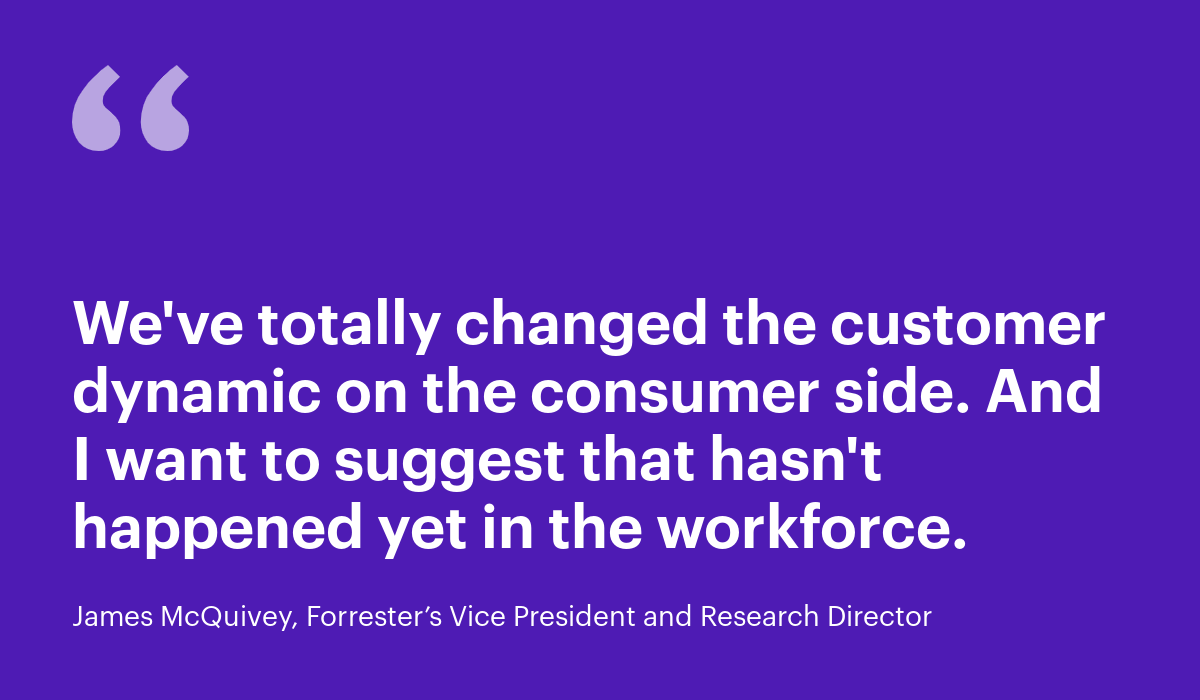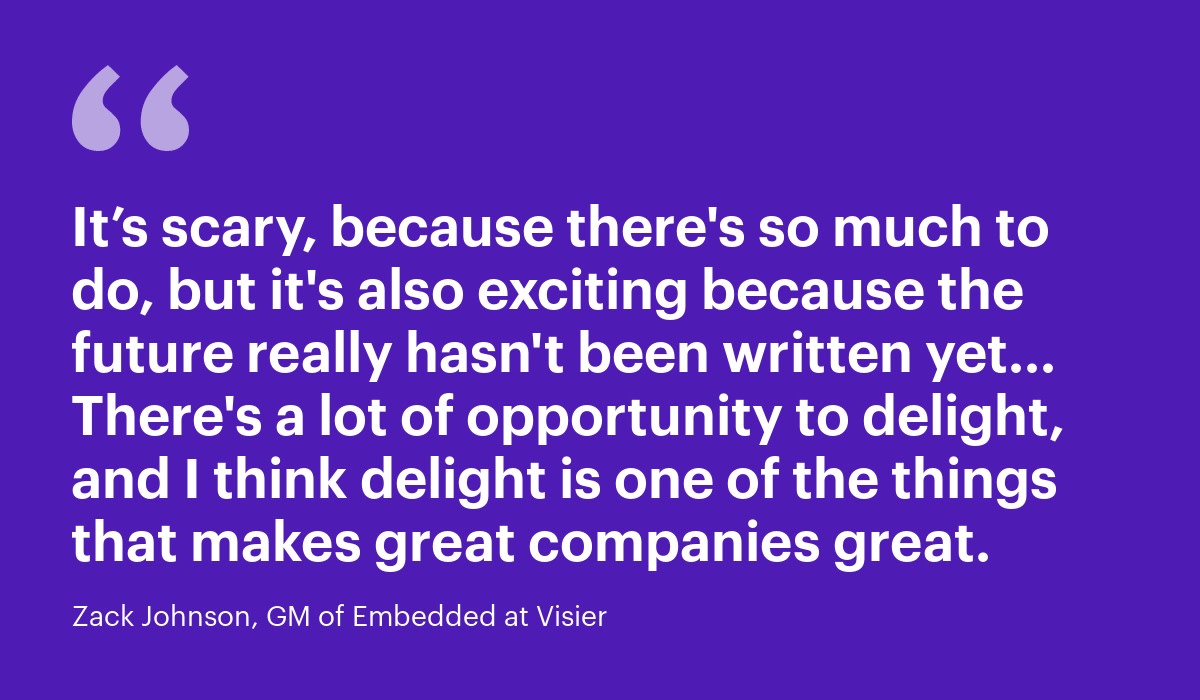Data Monetization: How to Turn Your Data Into Dollars
What is data monetization? Learn how vendors can monetize their data and the challenges they might face along the way.

Data represents a massive untapped resource for vendors and customers alike. And embedding analytics lets vendors transform the data they already collect into a value-building, revenue-generating powerhouse—while bringing customers the actionable insights they need.
“All work is people meeting and working together and figuring things out and solving problems,” says Zack Johnson, Visier’s GM of Embedded. “But if you think about just how much we understand what makes one team more successful than another, we’ve only begun to scratch the surface.”
To dig deeper into how vendors can monetize their data and what challenges they might face along the way, we share insights from Visier’s GM of Embedded, Zack Johnson, and Forrester’s Vice President and Research Director, James McQuivey.
The evolution of data
The last 20 years have seen an explosion in the use and prevalence of data and analytics. Consumer data led the way, with companies collecting and leveraging real-time data on their customers to reach them in new ways and with new products.
“We’ve totally changed the customer dynamic on the consumer side. And I want to suggest that hasn’t happened yet in the workforce,” says James McQuivey, Forrester’s Vice President and Research Director.

Employee experience has been a key focal point for organizations eager to participate in the people-focused workplace, but only about half of organizations currently have an employee experience function, says James. And organizations are still adapting to a data-driven culture from the “gut call” ethos of the past.
“My first thought is put the workers, their journeys, their thoughts, their stories, their needs at the center. The data has to be fundamental to that. Not only because it’s data that you haven’t had before and didn’t know what to do [with], but also because you can’t scale without it,” says James.
From his work at Forrester and the number of calls he receives on the subject, James believes the rate of change toward the people-focused, data-driven workplace will only continue accelerating.
And Zack agrees. “We’re seeing more and more, not only is there urgency to solve these problems from the customer, but they’re willing to switch vendors to do it,” he says.
The challenges of managing customer expectations
Customers may know that their data is powerful, but many struggle with how to access and derive meaning from it. This is where the HR technology vendor comes in.
“What’s going to have to happen to HR technology vendors is trying to raise your hand and say, ‘We are your strategic partners in this. We are going to help you think about ways to do this and then implement ways to do this.’ And then it’ll just open doors for more things that need to be done,” says James.
This can put the vendor in the difficult situation of being all things to all people—a helping hand to guide the novice and a provider of powerful, cutting-edge analytics for the experienced—who can bridge the gap between the problem a customer needs to solve and the data that can solve it. With such a wide range of experience levels and expectations, it’s challenging for a vendor on its own to create a single user experience that will appeal to users across the board.
“It’s scary, because there’s so much to do, but it’s also exciting because the future really hasn’t been written yet. And so there’s a lot of opportunity to innovate. There’s a lot of opportunity to delight, and I think delight is one of the things that makes great companies great. It’s really hard to rip and replace delight,” says Zack.

Data’s cheap, but insight and action are valuable
“The end user is more and more expecting the data’s free, that access to it and sophisticated tools for getting into it is just part of the process,” says James. “The service model can’t ever be perceived as holding back obvious data that should really just be released into the regular ongoing processes of the end user.”
But this doesn’t mean that vendors can’t monetize the data they collect. “So you have to provide some level of analytics, data access that goes beyond reporting in whatever your basic solution is. But I do see—and we have tons of examples of—customers paying for enrichment,” says Zack. “You have to take them on a journey. And I find that the enrichment journey also lines up with a pricing and packaging journey.”
Instead of paying for access to the data, customers pay for the value and actionable insight that they get from the data. This can include access to more specialized analytics, like predictive analytics and benchmarking, or guidebooks that lead them through the questions they need to be asking of their data.
Analytics as art and expression
“A payroll system is a payroll system is a payroll system,” says Zack. “So then why do people switch? It’s because each one has its own unique perspective on how HR management and work should happen.”
Analytics can be another expression of that perspective. “What are the metrics that you should watch? What does a good company look like? What are the benchmarks you should follow and manage against? What are the questions you should constantly ask to make sure you’re doing the right things?” asks Zack.
The answers to those questions shape a unique point of view and a way for vendors to differentiate themselves in a crowded landscape.
“I don’t know that everyone who’s in a tech vendor role thinks, ‘Oh, do I want to think of this as art?’ You should. You want to think of this as art. You want to think of this as a chance to paint the canvas, choose the colors, make it look and feel different in a way that other people are going to see it and say, ‘OK, that’s not just a three-year-old dribbling paint on a piece of paper. That’s a major artist,’” says James.
Selling the hero moment
The value of analytics, Zack says, isn’t in a particular chart or capability. It’s when your boss needs a quick answer on a Friday afternoon, and you have the answer at your fingertips.
“It’s looking like a hero, honestly, when the tough question comes. And if you can show your customer that in the sales process, you’re going to win more deals because they’re going to imagine themselves in that experience, and they’re going to realize that analytics isn’t about locking yourself in a room and being stuck in a spreadsheet. It’s literally coming to the meeting and knowing,” says Zack.
The market is made up of small moments of delight when you make something so much easier for one person, and those small moments add up to create the kind of customer engagement from which multimillion-dollar ARRs are made.
“Getting someone from sensing that they have a need to immediately, ‘Oh, there’s one button to click and I have it.’ Oh, that’s the most thrilling thing ever,” says James.
Unlock data monetization at your organization
Monetizing data can be an important new revenue stream for HR technology vendors, but providing analytics that connect with customers of all experience levels and go beyond basic reporting is a heavy lift. Success will require strategically partnering with customers, selling value instead of data, and creating a unique perspective to stand out in the market.
Embedding with Visier can cut out the guesswork and get you to revenue faster.
Interested in learning more? Visier’s GM of Embedded, Zack Johnson, and Forrester’s Vice President and Research Director, James McQuivey, discussed how to monetize data and what vendors need to know in an on-demand webinar, Turning Your Data Into Dollars: Monetize with Embedded Analytics. Access the full recorded session here.


